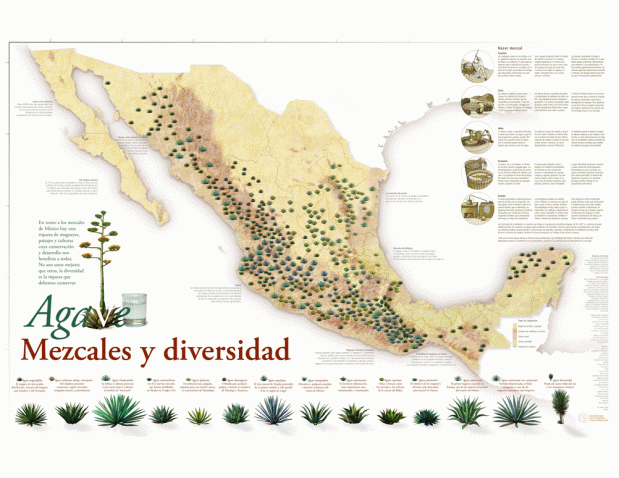Agaves, Mexican heritage
Certainly, the maguey (agave) is a wonderful plant, as described by the great botanist Carl Linnaeus in 1753 when he named this genre “Agave” (from Greek Agavo: something great, illustrious, noble, wonderful). Particularly in Mexico, every town with agaves developed a culinary culture associated with these plants. Whether to make popular beverages such as pulque, mezcal, tequila, bacanora, raicilla, xtabentún, aguamiel, atole de aguamiel, etc.; or as an ingredient for some meals such as mixiotes, earth oven lamb barbecue, pancita, sweet quiote, etc,. or its derivatives as agave worm-salt, chinicuiles sauce, etc.
The name maguey comes from Caribean language, nevertheless there are many regions with the indigenous population that still call this plant after their native language name:
| Name: | language | Name: | language |
| Metl: | Nahuatl | Uada: | Otomí |
| Doba: | Zapoteco | Guarú: | Mazahua |
| Cachro: | Popoloca | Haamxö: | Seri |
| Akamba: | purépecha | Hepe: | Zoque |
| Ki: | Maya | Tzihim: | Huasteco |
| Natsu: | Mazateco | Xuni: | Matlatzinca |
| Yavi: | Mixteco | Yu’wa: | Tlapaneco |
| Mai: | Huichol | Cuu’u: | Mayo |
| Muaíj: | Cora | Huue: | Triqui |
| Yi va: | Cuicateco | Al-mal: | Chontal |
In certain towns stronger bonding with magueyes were developed. Nowadays we can see this bonding in the vast variety of uses given to this plant. Mezcal in particular, is one of those typical Mexican products, due to the wide distribution of agaves throughout Mexican territory. This drink can be found in different towns all along Mexican territory and its origin dates from several generations ago.
But when did it first began?
Mezcal was born with Mexican miscegenation. The most accepted version says that the Spaniards were the ones who brought the distillation equipment, “the still” who in turn adopted it from the Arabs. However, other theories suggest that its origin may come from the Pacific. Such as in the case of mezcal producers who use so-called “Filipino distillers”, also known as the famous clay pots distillers, from where “mezcal de olla” comes from. The thing is that these technologies coupled really well with the diversity of agaves already known since then by the various towns of the indigenous population who lived in the regions of Mesoamerica and Aridoamérica. Especially in Mesoamerica this two elements (distillers and agaves) formed a new amalgam and thus a new product was born, MEZCAL.
Today, Mexico has become emblematic for beverages like mezcal, tequila, and bacanora. Its great tradition is reflected in the need to protect these products through Certificates of Origin and their correspondents regulations the Mexican Official Standards (NOM-070-SCFI-1994 “Mezcal” NOM-006-SCFI-2012 “Tequila” and NOM-168 -SCFI-2004 “Bacanora”).
Each master mezcalero (different ones from mezcal PhD degrees who make a very respectful job introducing new people to mezcal world but in this case the ones who were born in the media as in the case of family tradition mezcal producers) print their job in the mezcal process, and thereby agave soul is distilled. Each generation has perfected their technique and has given an additional touch to their product. Today, there is a present legacy that Master Mezcaleros have inherited from their ancestors. This legacy is the knowledge of the process of making artisanal mezcal.
However, there is a risk of being lost if new generations of young fail to fairly and equitably incorporate in the production value chain. This implies that both the market recognizes Artisanal Mezcal as a traditional and handmade quality Mexican product, and secondly, that the new generations of Mezcaleros (mezcal-producers) become aware and able to identify the needs of a contemporary and changing market. Often, this means that new mezcal-producers should develop more efficient and innocuous manufacturing processes for mezcal without losing the artisanal aspect that differentiates them.
And finally, it’s important that both producers and consumers recognize the importance of Mexican regulations regarding the harvest of wild agaves, up to now ignorance has only generated ecological damage and today many mezcal-producers have been pushed to abandon this activity due to lack of raw material for mezcal producing. Fortunately, there are some towns where for the sake of sustainable production of mezcal, have developed alternative production schemes in order to preserve natural resources of their region, generating new jobs for their local people.
Cirial (Agave karwinskii Zucc.) and espadín (Agave
angustifolia Haw.) agave heads ready for been cooked.
Traditional earth oven uncovered after agave cooking.
Cooked agave heads grist
Preparation y Fermentation of agave broths after its milling.
Distilation of agave broths in clay pot distillers in order to obtain mezcal.
Alcoholic degree measurement in mezcal using a
reed venencia and a jícara (a type of cucumber shell).
Having said the above, we hope we have accomplished once more with the mission of our blog.
To Defend Mezcal
Cheers!!!









